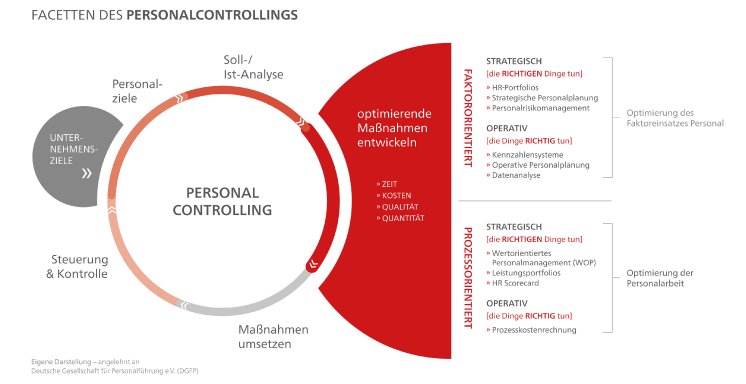According to this definition, both strategic planning and operational HR planning are aligned with HR objectives and, accordingly, with corporate goals. Good HR planning is characterized by regular status determinations and plan/actual analyses in order to be able to identify potential quantitative or qualitative personnel bottlenecks or surpluses in good time. Only in this way can controlling measures be initiated to correct unwanted developments and align them with the set goals (see figure Facets of personnel controlling).
In the strategic and operational context, both personnel requirements and headcount planning are carried out. In order to be able to derive qualification-specific statements on the coverage of future personnel requirements, a functional and structural grouping of requirements and headcount (e.g., by function group, job families or similar structural characteristics) must be carried out.
The following questions are central to personnel requirements planning and workforce scheduling:
- How many personnel are needed?
- What qualifications (know-how) must this personnel have?
- Where is this personnel needed?
- When is this personnel needed?
In personnel requirements planning, a fundamental distinction is made between deployment, reserve, new or replacement requirements. The decisive question here is how the identified requirements are to be covered. As the current situation on the labor market often makes it difficult to recruit new staff and expand the workforce, increasing efforts are being made to identify and harness unused potential for meeting demand - especially in the context of qualitative workforce planning and deployment and reserve requirements.
By contrast, workforce planning - also known as workforce management - is carried out on the basis of the current workforce, supplemented by already known developments (e.g., retirements, expiration of fixed-term contracts, transfer of trainees) and assumptions made (e.g., promotions). This personnel planning step can also take place by the manager.Since this planning is based on existing facts and data, the use of software-based workforce planning can significantly reduce the effort involved.
Already known developments can be automatically extrapolated and intuitively supplemented with assumptions made. Furthermore, this type of planning offers the possibility to develop and subsequently compare different scenarios. For example, the effects of opening an additional location can be made transparent. In such a software-based solution, both personnel planning and personnel cost planning are usually carried out.
SUPPORT FROM PEOPLE ANALYTICS / HR ANALYTICS
INFLUENCING FACTORS AND THEIR SIGNIFICANCE FOR PERSONNEL PLANNING
DASHBOARDS FOR THE INTERACTIVE ANALYSIS OF HR DATA
Read the full article by Kay Kamphans and Arlett-Sophie Magdanz on nc360°, the noventum info platform.



